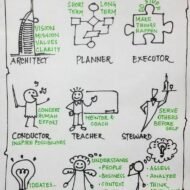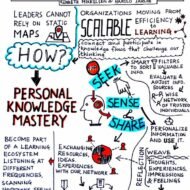Posted by Managementguru in Entrepreneurship, Human Resource, Leadership
on Sep 8th, 2015 | 0 comments

What is Leadership The one who quickly diagnoses a problem, shoulders personal responsibility and makes the right decision can be called a true leader. He need not be rich, need not hold a big office, need not be numero uno – as simple as that. Understanding other people well is also a core leadership quality. If a person is late to work, a leader tries to unearth the cause of the problem; rather than looking for the worst in people they look for what’s best within them. Entrepreneurs have a set of leadership skills that make them a little different from every other worker bee. They choose to walk down the road less traveled by breaking away from corporate protocol and venturing out on their own, bucking trends and at times, even breaking the rules. “Success is actually a creative pursuit and a reflection of healthy self-esteem.” What will you do to be the leader that you are destined to be, today? Thinking outside the box and forging your own path requires agility. Being an agile leader refers to remaining flexible, growing from your own mistakes and rising above the wide array of challenges you face. “If you call a stumbling block a “problem” or a “big mess” you will create a different emotional state within you than if you call the issue “an opportunity” or a “challenege that will make me better.” “The most successful human beings are wildly focused. They have a very clear picture of what it is they want to create by the time they reach the end of their lives and then they have the discipline (and courage) to stick to their mission – saying “no” to everything that is not mission critical. Who made Success a Bad Word? “Too many people believe that playing their best game as a human being requires them to revolutionize their lives. And for most of us, that’s a scary thought.” We humans love to play within our comfort zones. Making changes to the way we think, feel and behave is next to impossible for us. What people fail to realize is that changes are to be welcomed because they are chances to improve our life quality. If you don’t adapt or go with the flow, you will definitely feel the heat when priorities start pushing you to the brink. “The best way to get to your greatness is through small, continuous steps-what I call the “1% Wins”. Agile leaders have a set of shared characteristics: being extroverted, taking charge and challenging the status quo. Basically, it’s people who have been described as “difficult to manage.” Being difficult doesn’t have to be a bad thing. It just means that certain people have their own way of doing things and are able to generate new ideas because they possess the ability to view issues from multiple angles. Simplify Then Focus Simplifying life and stripping away all that is unimportant can help you to achieve your dreams. Once you do your clean up, focus, focus, focus. You’ll be surprised how good you will then get at being great. “The best way to create spectacular results in the most important areas of your life is through daily practice.” “People who have achieved great success are not necessarily more skillful or intelligent than others. What separates them is their burning desire and thirst for knowledge. The more one knows, the more one achieves.” ~ Robin Sharma Curated from The 4 Abilities Required of Agile Leaders and Little Black Book for Stunning Success by Robin...

Posted by Managementguru in Business Management, Entrepreneurship, Human Resource, Leadership, Organisational behaviour, Principles of Management
on Mar 9th, 2014 | 0 comments

Profile of a successful leader Adaptive Capabilities: Leaders need to radically change their mindset so as to stand the test of time; but the core leadership attributes like vision or creativity, intelligence, commitment, and a healthy dose of luck still continue to define the pre-requisites of success. Integrity of Character is most important when talking about successful leadership. The philosophical undercurrent is that “Be Good, Do Good” and you will be good. The motive must be devoid of mistakes though there is room for mistakes in judgment. Leaders must have a clear vision and be able to communicate this vision to others so that it becomes a shared vision and everybody willingly contributes in fulfilling the vision. Six ‘C’s or six criteria that determine a leader’s credibility Conviction Character Care Courage Composure Competence Cross-Functional Expertise – Acquisition of knowledge should make a leader humble and flexible and gaining knowledge must be seen as a life long experience rather than collection of voluminous data or skills. A leader will try to apply his broad functional knowledge and expertise in the right places and the results will be definitely magnificent. A leader must look into the possible options rather than to plan, the possible rather than the perfect, involvement instead of obedience. Change is the only entity that remains unchanged and it is inevitable for the leaders to consider change as the core element of growth. With accelerated pace of change in the economic, political and socio-cultural environment, leaders not only need to acquire new knowledge and skills but they also need to unlearn many of the things that have out-grown their purposes. Leaders should follow the CODE OF PRIDE to motivate the workforce. P– PROVIDE FOR A POSITIVE WORKING ENVIRONMENT R– RECOGNISE EVERYONE’S EFFORTS I– INVOLVE EVERYONE D– DEVELOP SKILLS AND POTENTIAL E– EVALUATE AND MEASURE CONTINUOUSLY In large corporate organizations, the leader must be willing to share power and control so that leadership is encouraged at various levels. Successful leaders are those who are self-motivated by setting their own standards and compete with themselves. Innovation is the need of the hour What do you mean by innovation? Creating something new or modifying the old one. Here the term innovation implies the change in the “THOUGHT PROCESS” of leaders who are able to turn a crisis into an opportunity. Also called as “THINKING OUT OF THE BOX” where a leader finds new application for old ideas which cannot be discarded or dis-regarded. “You must learn from your past mistakes but not Lea(r)n on your past successes”. High achievers take moderate risks calculating the circumstances and they rely on their own abilities unlike low achievers who invariably like to minimize risks or take wild and irrational risks. Running a corporate business has become more like an experiment since we cannot control or predict the future. It is highly unstable and unpredictable. So leaders have to cope up with this non-linear force acting in the external environment building up pressure. Leaving things as they are can be just as predictable as changing everything, you lose or win both ways. Now let us look at some of the definitions of Leadership 1. “Leadership is generally defined as influencing people so that they will strive willingly towards the achievement of group goals.”- Koontz and O’Donnell 2. “Leadership is the lifting of man’s visions to higher heights, the raising of man’s performance to higher standards, the building of man’s personality beyond its normal limitations.”- Peter F.Drucker 3. “Leadership is the ability to secure desirable actions from a group of followers voluntarily without the use of correction.”- Alford and Beatty 4. “Leadership refers to the quality of the behavior of individuals where by they guide people on their activities in organized efforts.”- Chester I.Bernard Behavioral Commitments of a Leader: Challenging the process Challenging the status quo and act as radical change agents Inspiring others by being pioneers, instigators, navigators and learners Showing risk-taking ability,...




